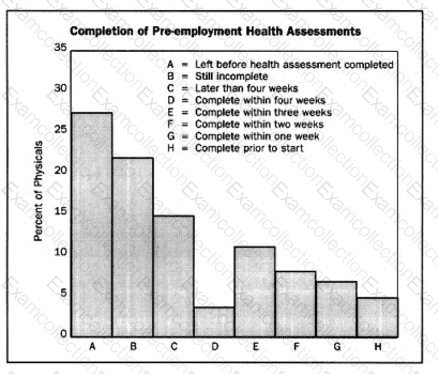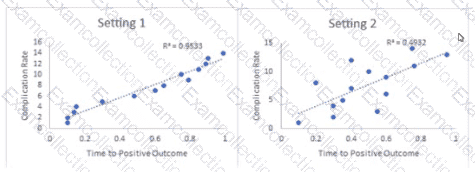NAHQ CPHQ - Certified Professional in Healthcare Quality Examination
An outpatient medical clinic wants to test whether a relationship exists between two factors: lack of available transportation and the number of times patients do not keep appointments. Which of the following tools should be used?
An employee health program includes a pre-employment health assessment for all prospective employees. The assessment is to be completed and the results known prior to the assumption of duties. A retrospective study of 200 employees resulted in the following chart:

Analysis of the chart shows which of the following conclusions?
Which tool is used to establish and track timelines for project completion?
Which of the following demonstrates interrater reliability and construct validity for an instrument designed to capture data for a publicly reported measure set?
Option
Interrater Reliability
Construct Validity
A
Two or more abstractors enter identical responses when reviewing the same record.
The tool measures the quality of care which the measure developers intended to measure.
B
Trained data collectors can reliably predict results after reviewing a random sample of records.
The tool includes data elements that measure the aspects of quality which are important to the public.
C
Concordance between process and outcome measures can be accurately estimated by the measure developers.
The instrument enables statistically valid inferences to be drawn about the quality of care delivered.
D
The design of the instrument minimizes falsified answers and other data entry errors.
The instrument captures variations in care processes across the population.
Supporting patients through longitudinal care plans is the guiding principle of:
A continuous survey readiness program requires which of the following?
Senior leaders of a managed care organization have consulted a healthcare quality professional on the purchase of a clinical data management software system to support performance improvement. Which of the following should be considered first?
A new process improvement team has just completed unstructured brainstorming on reasons why healthcare-acquired infection rates are increasing. Which tool would be most helpful to sort through brainstorming ideas?
An organization has compiled the scatter plots below:

Based on these plots, which of the following conclusions can be made by the quality professional?
A nurse inadvertently hung an IV medication on the wrong patient’s IV pump, but discovered the error prior to initiating the infusion. Patient harm was averted, and the nurse disclosed the error to a healthcare quality professional. The quality professional should
Which of the following technology enhancements will help the hospital most accurately identify hospital-acquired condition rates?
Using the Information below, which patient population Is at the highest risk tor tailing?
A healthcare organization has two years of data on infection rates by month. Which of the following process tools would be best to use for analyzing this data?
To best achieve a low rale of harm In spite of Inherent risks In healthcare, an organization must
Reviewing organizational priorities, addressing regulatory requirements, and identifying goals for the next year are important components in the development of which of the following?



